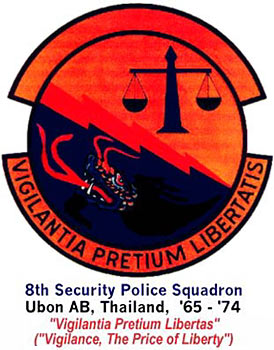
8th
SPS!
Ubon
Air Base
NVA / Target UBON RTAFB!
July
28, 1969,
January 13, 1970,
June 4, 1972
© 2000 by Kelly
S. Bateman
8th SPS,
K-9 Sentry Dog Handler,
(Baron 279M) 1970-1971
|
8th SPS - I was not at Ubon RTAFB, Thailand during
any of the three Sapper attacks mentioned in this 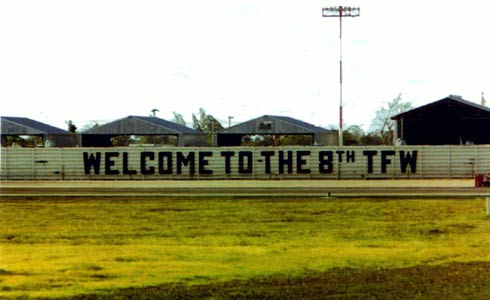 article.
I did however know several Sentry Dog Handlers and Security Police personal
who were there and heard their firsthand accounts of the July 1969 and January
1970 attacks. The information contained in this article is the memories of
these accounts and official USAF after action
battle
reports
obtained from the USAF Records Center, Maxwell AFB, GA.
article.
I did however know several Sentry Dog Handlers and Security Police personal
who were there and heard their firsthand accounts of the July 1969 and January
1970 attacks. The information contained in this article is the memories of
these accounts and official USAF after action
battle
reports
obtained from the USAF Records Center, Maxwell AFB, GA.
I hope this article will give the reader a
better understanding of the mission and role of the USAF in Thailand
during the Vietnam War. The USAF Combat Security Police were the infantry
of the USAF. Their mission was to protect and defend US Air Bases in Thailand
and Vietnam, 24 hours a day 365 days a year, from enemy attack. In doing
so they allowed the aircraft stationed at these bases to fulfill their
mission of attacking and destroying the enemy. No matter the final outcome
of the war, the contribution and sacrifices made by USAF Combat SPSs helped insure, for the duration of the war, the skies over
Southeast Asia belonged to The United States of America.
Ubon RTAFB was probed and
tested by enemy Sappers many times. Three times,
full-scale attacks occurred. The first occurred on July
28, 1969, a second on January 13, 1970 and
a third attack on June 4, 1972.
|
July
28, 1969
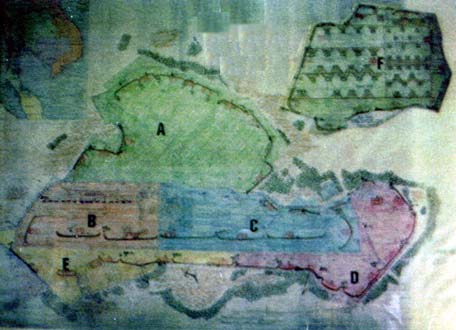 The
time was 0130 hours, 28 July 1969 and it was starting
to rain again at Ubon RTAFB. USAF Sentry Dog Handler
A1C Kenneth D. O'Dell and his Sentry Dog Sheafer (X846)
were posted on ub's northeast perimeter at post Echo-77.
It had been raining at Ubon off and on all night, but now
the rain was on again, so it was time for rain gear. As
A1C O'Dell put on his rain top he was fired on by three
sappers, who were approximately 30 yards inside the perimeter
fence and lying only 20 yards away in the tall grass. He
and Sheafer were now between the intruders and the perimeter
fence, blocking the sapper's escape route. Running toward
the perimeter concertina wire the sappers fired several
more bursts in O'Dell's direction. Now the sappers were
within 10 yards of the perimeter fence. The
time was 0130 hours, 28 July 1969 and it was starting
to rain again at Ubon RTAFB. USAF Sentry Dog Handler
A1C Kenneth D. O'Dell and his Sentry Dog Sheafer (X846)
were posted on ub's northeast perimeter at post Echo-77.
It had been raining at Ubon off and on all night, but now
the rain was on again, so it was time for rain gear. As
A1C O'Dell put on his rain top he was fired on by three
sappers, who were approximately 30 yards inside the perimeter
fence and lying only 20 yards away in the tall grass. He
and Sheafer were now between the intruders and the perimeter
fence, blocking the sapper's escape route. Running toward
the perimeter concertina wire the sappers fired several
more bursts in O'Dell's direction. Now the sappers were
within 10 yards of the perimeter fence.
Photo: Wall map at
Ubon RTAFB Sentry Dog Kennels,
showing A, B, C, D, E, and F Sectors of the base.
After
releasing his dog, A1C O'Dell advised CSC (Central Security
Control) that Echo-77 was receiving hostile fire and was under
attack. In an effort to return fire the airman dropped to the
prone position. He now found his line of fire blocked by a
mound of dirt between him and the intruders. Rising to a kneeling
position O'Dell found his line of fire again blocked but this
time by his dog Sheafer who was pursuing the intruders as they
made their way toward the fence. O'Dell then ran to a new position
near the fence where he was again fired upon as the sappers
escaped through the perimeter wire.
CSC radioed all USAF 81mm mortar
pit crews to fire flare illumination to help to locate
the hostile force. Echo 2 and Bravo 2 SAT teams arrived
at Echo-77 and deployed at the point where the sappers
had exited the base. As the SAT Teams deployed both
A1C O'Dell and his dog Sheafer were found to be wounded,
and were quickly evacuated to the base hospital. A1C
O'Dell was wounded in the left knee and Sheafer was
hit in the left shoulder. Both would recover.
|
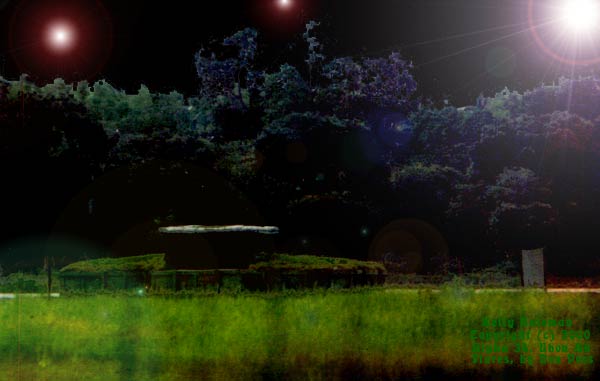
Photo: View looking over Machinegun Bunker, Alpha-34,
toward the jungle on the perimeter, Ubon RTAFB, Thailand.
The Sapper Team had penetrated onto
the base, planted their satchel charges and were in the process
of escaping when they encountered the K-9 Sentry. At 0200 hours
several "Blind Bat" flare ships dropped flares over the base
while a sweep was made by the SAT's and QRT's for more sappers
and any planted explosive charges. At 0215 hours, several C-47
aircraft parked on the taxiway near the Base Operations building
were rocked by detonated satchel charges planted earlier by
the sapper team. Nineteen flares were then dropped by airborne
AC-130 flare ships over Echo and Delta sectors as SAT, QRT
and K-9 Security teams swept these areas for more hidden enemy
personal and explosives. Luckily none were found. No enemy
were killed or captured and the damage to the parked aircraft
was serious but was repaired quickly. It had been a long night
but this attack was over. The following day ground searches
of the on base and off base perimeter turned up various items
discarded by the sappers. Found was black clothing, unexploded
Satchel charges, 9mm NVA ammo clips, and other various items
of Chinese and North Vietnamese military equipment. The sappers
had understandably been in a big hurry and it showed. They
left a trail of abandoned equipment as they escaped across
the runway toward the perimeter fence and out into the jungle
beyond.
Between 1969 and the early 1970's an
escalation in U.S. ground and air combat activity in the Vietnam
War brought a like response from the North Vietnamese. As before,
the combat aircraft from bases in Thailand and Vietnam were
greatly damaging to the enemy with day and night air strikes.
The USAF bases in Vietnam and Thailand again became a prime
target for the VC and NVA Sapper Teams whose goal was to stop
the these aircraft from leaving the ground. Ubon airfield was
no exception.
On the afternoon of November 26,
1969
at the outskirts of
Ubon City, Thailand, a fifteen year old Thai boy was playing
at his home next door to the abandoned Ubon distillery. While
playing, he observed three armed men dressed in camouflage
fatigues move through the distillery grounds and quickly
disappear into the dense jungle that surrounded his neighborhood.
That same day, three armed men had seized food from five
young boys as they played outside their village fourteen
kilometers northeast of Ubon Air Field. After threatening
the boys those men quickly disappeared into the nearby jungle.
During the several months preceding these two
incidents, local Thai and Vietnamese informants had provided information
to the Thai Air Force and the USAF OSI (Office of Special Investigation)
regarding the movement of communist insurgents and their supplies into the
area within a thirty kilometer radius of Ubon Air Field. The specific information
then was "three brave North Vietnamese Sapper teams", along with arms
and explosives, were infiltrated from North Vietnam through Laos into the
area of a Vietnamese Village located near Ubon City and Ubon Royal Thai Air
Force Base (Ubon Air Field). The weapons and explosives were reportedly to
be used for sabotage of communications facilities, airfields, Thai Government
Buildings and an unnamed American Air Base in Thailand. However, the location
of this enemy supply cache was not known by any of the informants. Many reports
such as these were received monthly by the Thai an U.S. Intelligence gathering
units. Intelligence would then analyze the information in these reports and
pass it on to the affected USAF and US Army units and commands stationed
in Thailand.
January 13, 1970
Unlike the 10 weeks preceding the July
1969 attack, the month of January, 1970 saw a decrease in the
number of reports of insurgent activity in the thirty kilometer
area surrounding Ubon airfield. Although the number of insurgent
reports had fallen the violence of the encounters had escalated.
One such report received during this time period stated that
the village chief of Brut Ha Knew, II kilometers from the airfield
was questioned, then beaten by two unknown Vietnamese men after
failing to Satisfactorily answer their questions regarding
the defenses and armament at Ubon RTAFB. They then left the
village after firing several shots over the heads of the remaining
witnesses.
The number of encounters between
armed information seeking, insurgents and the local population had dropped
off significantly, however this was about to change.
The day before the attack, at 2115
hours on January 12, 1970, the
Thai Provincial Police in Ban Pratham reported to Ubon CSC
that an armed force of 16 men, dressed in dark clothing,
was traveling in the direction of Ubon Air Field. The report
stated that this group had disappeared into the jungle before
they could be challenged. CSC then issued a Condition
Yellow Alert for the base at 2121 hours.
All was quiet until 0201 hours
on January 13, 1970. It was then
that the Echo Sector SAT Team, posted on the northeast perimeter
of the base, radioed Security Control that they could hear automatic
weapons fire coming from the vicinity of mortar pit, Echo-78. The
mortar pit crew at Echo-78 then confirmed by radio to CSC that
they were under attack.
Airman Larry Bridges, the K-9 Sentry at Echo-75, also radioed
that he was being fired on by 5 or 6 unidentified persons, approximately
10-15 yards inside the perimeter fence and 30 yards away from his
position in front of machinegun bunker Echo-44. K-9 handler Larry Bridges
later stated that his dog, King (A642), had alerted on the intruders
as they peered over a slight mound of dirt. At the same time the
sappers spotted him and his dog, and both had begun to fire at each
other simultaneously.
K-9 handler Airman Larry Bridges' fire
was supported by the M60 machinegun and M16 being fired by the mortar pit
crew at Echo-78. Four of the intruders then ran in a low crouch toward the
active runway and the aircraft parked on the opposite side. At 0202 hours, Red
Option I was implemented by CSC. The attack had started and the chase
was on.
As the 4 intruders drew
abreast of K-9 Sentry Echo-75, he released his dog. USAF Sentry Dog King
(A642) ran to attack the sappers as he had done so many times before in training
with his handler. Two of the sappers then ran west following the perimeter
fence in front of mortar pit Echo-78. Echo-78 now ceased firing toward the
insurgents running toward the runway and turned their fire toward the perimeter
fence and the two escaping sappers. The Machine Gunner in bunker Echo-36
also turned his fire toward the perimeter as did K-9 Sentry Echo-75, who
was now pinned down in front of bunker Echo-36 without his dog. By this time
the sounds of gunfire and the loud hurriedly shouted radio transmissions
to CSC could be heard by all on duty base security forces. Every Security
Policeman and Thai Guard now knew that the base was under full attack.
At
0203 hours Echo Area SAT radioed CSC that a large explosion had just occurred
on the northeast perimeter fence line. This Explosion came from in front
of bunker Echo-36. Echo-36 had fired an M-79 grenade at point blank range,
hitting one of the escaping sappers who was carrying Satchel charges strapped
to his body. His body was literally blown apart. His hair and scalp hanging
on the concertina wire and one leg found in front of bunker Echo-36 were
all that remained of this individual sapper.
|
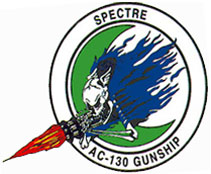 CSC
now radioed all base security forces that the Thai Army had responded
and were converging on the outside base perimeter of the base.
At 0205 hours Bravo Area SAT radioed that they were receiving fire
from four intruders running west across the runway toward the AC-130
Specter Gun Ships parked adjacent to Taxiway-3. Bravo SAT then
returned this fire with their M60 machine gun mounted on their
mobile jeep. At the same time K-9 Sentry Bravo-72, Sgt Thomas Cartwright
Jr., posted east of the AC-130 parking area, released his dog Jody
(89X1). He then dropped to the prone position and opened fire on
the sappers with his M16. One of the sappers fell wounded. Seeing
this the three remaining insurgents turned their fire on Sgt Cartwright
and K-9 Jody. Sgt Cartwright fell wounded taking one round in the
leg, and Jody fell with one round in his neck.
CSC
now radioed all base security forces that the Thai Army had responded
and were converging on the outside base perimeter of the base.
At 0205 hours Bravo Area SAT radioed that they were receiving fire
from four intruders running west across the runway toward the AC-130
Specter Gun Ships parked adjacent to Taxiway-3. Bravo SAT then
returned this fire with their M60 machine gun mounted on their
mobile jeep. At the same time K-9 Sentry Bravo-72, Sgt Thomas Cartwright
Jr., posted east of the AC-130 parking area, released his dog Jody
(89X1). He then dropped to the prone position and opened fire on
the sappers with his M16. One of the sappers fell wounded. Seeing
this the three remaining insurgents turned their fire on Sgt Cartwright
and K-9 Jody. Sgt Cartwright fell wounded taking one round in the
leg, and Jody fell with one round in his neck.
By this time, three USAF
81mm mortar pits were providing continuous flare illumination that cast a
red glow over the base and the events that were unfolding around the running
battle for the AC-130 aircraft. Barrel flares, pointing outward along the
perimeter of the base, were now ignited to better see any enemy that might
be staging for another attack, or still crawling through the concertina wire.
Illumination made the black night almost as bright as day.
At 0206 hours, Bravo SAT
Leader radioed CSC that his SAT rider had killed two of the attackers. As
Sgt Cartwright and his K-9 Jody lay wounded, Bravo SAT took up the pursuit
of the remaining hostile force headed directly for the Specter Gunships! CSC
had dispatched a QRT to the area, and now the Bravo-SAT and the QRT were
involved in a heavy firefight less than 50 yards west of the sappers' targeted
AC-130s! These 2-man SAT Teams were equipped with a standup mounted M60
machinegun mounted in the back floorboard of their jeep. The SAT rider could
maintain a constant fire as the driver pursued the enemy force. They were
also equipped with M16's and Smith and Wesson .38 cal. Combat Masterpieces
revolvers as side arms.
At
0224 hours the QRT radioed CSC that all remaining insurgents had been killed
in the southwest corner of the AC-130 parking area--with no casualties
from the QRT or Bravo SAT.
|
But tragedy was was
only minutes away.
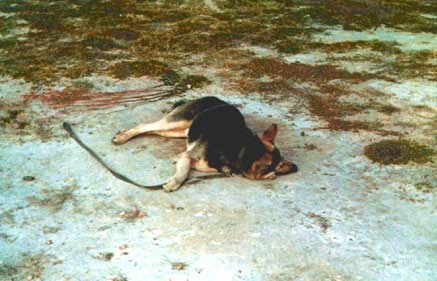 All
known sappers now lay dead, only yards from their targets.
One dead sapper was found behind the GCA generator 20 yards
from the parked aircraft. This sapper was later found to
be the one wounded by K9 Sentry Sgt Cartwright. Another
body found was discovered, that of wounded Echo-75 Sentry
Dog King. King, although receiving a shoulder wound from
the sappers during the early moments of the attack, had pursued
the VC across the runway and renewed his attack during the
final firefight and received a second wound from a crawling
sappers. Wounded, yet still determined to attack the sappers,
King continued crawling in wounded-pursuit, and was mistakenly
killed by the QRT Team who mistook him for a hiding sapper. All
known sappers now lay dead, only yards from their targets.
One dead sapper was found behind the GCA generator 20 yards
from the parked aircraft. This sapper was later found to
be the one wounded by K9 Sentry Sgt Cartwright. Another
body found was discovered, that of wounded Echo-75 Sentry
Dog King. King, although receiving a shoulder wound from
the sappers during the early moments of the attack, had pursued
the VC across the runway and renewed his attack during the
final firefight and received a second wound from a crawling
sappers. Wounded, yet still determined to attack the sappers,
King continued crawling in wounded-pursuit, and was mistakenly
killed by the QRT Team who mistook him for a hiding sapper.
At
0225 hours K-9 Sentry Sgt Cartwright and his dog Jody were
evacuated for medical care. Both recovered from their wounds.
C-123 aircraft from Ubon were now dropping parachute flares
over the area and the base was swept by SAT and QRT teams
for any remaining intruders. None were discovered. No aircraft
were banned. This night the NVA sappers lost five men. Four
sappers escaped. Their abandoned weapons and gear being found
the next day in the jungle 40 yards outside the base perimeter.
Unconfirmed reports by several local citizens placed from
one to four suspicious persons fleeing northeast after the
battle. The local population living in and around the Air Base
and the Ubon area always cooperated with military authorities
in passing on any information and early warning regarding
suspicious activity outside and around the base. Through
investigation after every incident of hostile activity directed
toward the Air Base found that the attackers had no local
support but were infiltrated and supplied from outside Thailand
by the NVA or Laotian forces.
|
|
|
|
| Sgt Thomas E. Cartwright, 8th SPS K-9 receives Bronze Star/v and Purple Heart, from Col.
Cummins.
|
Col
Cummins, Commander of the 8th Combat Group, presents the
Bronze Star/v and Purple Heart to Sgt Thomas E. Cartwright,
8th SPS K-9, for his actions and wounds received in the
Sapper attack on Ubon RTAFB, Thailand, January 13, 1970.
|
|
|
|
In 1970 Memorial Day ceremony,
Capt. Mills (Chief of 8th Combat Support Group) looks on
as Col. Cummins pins an honorary Purple Heart on the leash
of WIA K-9, Jody (89x1) for wounds received during the
January 13, 1970 base attack.
|
Col. Cummins
pins an honorary Purple Heart
on the leash of WIA K-9, Jody (89x1)
|
| | |
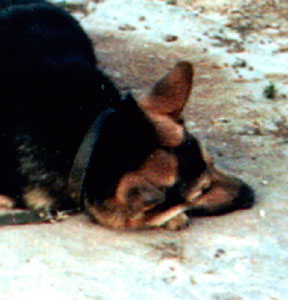
K-9 King (A642)
|
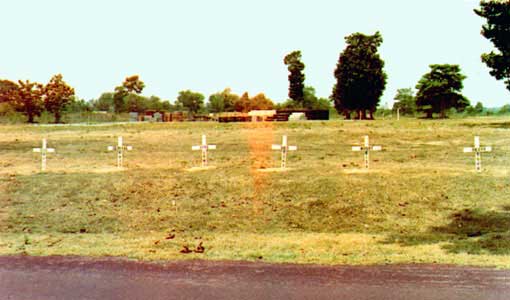 Rest In Peace, K-9 King (A642).
Rest In Peace, K-9 King (A642).
Ubon RTAFB, 8th SPS USAF
K-9 Cemetery
|
|
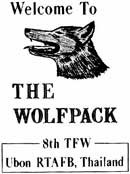 Insurgent
activity was recognized as a telling sign that combat missions
flown from bases in Thailand were adversely affecting the
enemy's Vietnam War effort. During the Vietnam War, combat
aircraft of Ubon RTAFB, and many other Air Bases throughout
Thailand, provided ground support for US military operations
in Southeast Asia. Day and night, F-4 Phantoms, and then
newly upgraded and modernized B-57G Fighter Bombers of ub's 8th
Tactical Fighter Wing, the "Wolf Pack", would fly combat
missions, carrying bomb loads to targets deep inside North
Vietnam and other strategic targets in the Vietnam War Theater. Insurgent
activity was recognized as a telling sign that combat missions
flown from bases in Thailand were adversely affecting the
enemy's Vietnam War effort. During the Vietnam War, combat
aircraft of Ubon RTAFB, and many other Air Bases throughout
Thailand, provided ground support for US military operations
in Southeast Asia. Day and night, F-4 Phantoms, and then
newly upgraded and modernized B-57G Fighter Bombers of ub's 8th
Tactical Fighter Wing, the "Wolf Pack", would fly combat
missions, carrying bomb loads to targets deep inside North
Vietnam and other strategic targets in the Vietnam War Theater.
Sharing the base facilities at Ubon were the AC-130 "Specter" Gun
Ships of the 16th Special Operations Squadron. Their unit
insignia was a flaming, grinning human skull with fire and
40mm cannon rounds spewing from its mouth(photo, right).
A very appropriate logo as you will see. The 16th SOS would
fly from Ubon to attack Vietcong and NVA targets inside Vietnam,
Laos and Cambodia. These highly modified AC-130 cargo aircraft were equipped
with the latest state of the art technology of their day.
|
| | The Specter Gun
Ships were outfitted with infrared night vision
equipment and on board computers to fly the aircraft
while at the same time firing their 40mm cannons, 105mm
cannons and the 20mm electric gattling guns. These
Aircraft could look through the thick jungle canopy
and camouflage of the HO Chi Min Trail and rain their
deadly fire on the enemy supply convoys and trucks
parked below. When over a target, the heat signatures
from the engines of the enemy vehicles below would
clearly show up on the airman's infrared heat sensing
monitors. This advanced technology made any and all
targets very visible even at night and in all weather
conditions.
| 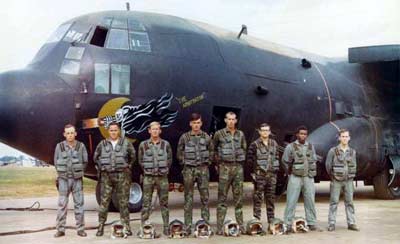
Photo: Courtesy, Phil Hawkshead Night photographers posing
in front AC-130 at Ubon Thailand "Arbitrator".
|
| | Day
or night, under the circling gun ships of Ubon RTAFB, there
was no safe place for the enemy to hide.
|
| | | |
| |
| 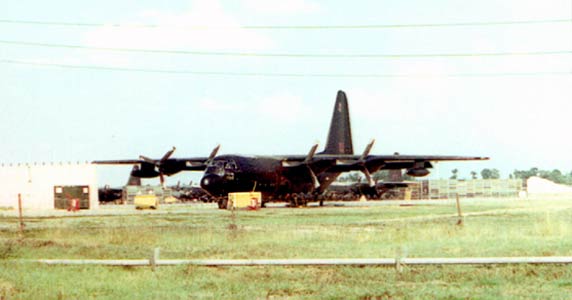
|
| | AC-130 Specter Gun Ship,
over Texas Tower Fox-56, Fox Sector, Ubon RTAFB, 1970.
| AC-130 Specter Gun Ship on the Ubon RTAFB taxiway.
1970
|
|
June 4, 1972
The cycle of attacks was again repeated
on June 4, 1972. The Base Security
force this night consisted of 138 USAF Security Policeman
and 207 members of the Thai Security Guard Force, CO
D, First Royal Thai Guard Regiment.
Photo: 8th SPS Sentry Dog Handlers
on Ubon RTAFB
flight line, just returned TDY from Vietnam. 1970
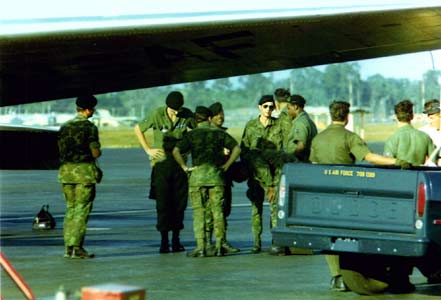 Intelligence
reports received on June 2, 1972 from Nankorn Phanom Province (NKP), Thailand
stated that 12 well trained Vietnamese had crossed the Thai border infiltrating
into Thailand. They were reportedly were on their way to Ubon City for
a sapper mission against Ubon RTAFB. Most were reported to be Vietnamese
refugees repatriated to North Vietnam where they received sapper combat
training for use against US facilities in Thailand. Intelligence
reports received on June 2, 1972 from Nankorn Phanom Province (NKP), Thailand
stated that 12 well trained Vietnamese had crossed the Thai border infiltrating
into Thailand. They were reportedly were on their way to Ubon City for
a sapper mission against Ubon RTAFB. Most were reported to be Vietnamese
refugees repatriated to North Vietnam where they received sapper combat
training for use against US facilities in Thailand.
At three minutes after midnight
on June 4, 1972, two SAT patrols were proceeding west on the perimeter road
of Ubon RTAFB adjacent to the village of Ban Na Mhang. They encountered
one individual running in a crouched position toward the AC-130 Specter aircraft
parking area. The patrol radioed Security Control of their sighting and pursuit.
CSC then dispatched Charlie Sector SAT, Charlie Sector Supervisor and the
Charlie Sector 6-man QRT Team.
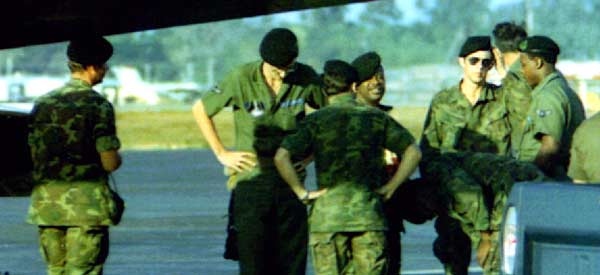 The
two SAT teams pulled off of the road and deployed from
their vehicles, issuing a verbal challenge in Thai
and English to the intruder to halt. The intruder failed
to stop and continued toward the parked AC-130s. He
penetrated the inner concertina wire security fence
approximately 20 yards in front of observation bunker
Charlie Three, manned by a Thai guard. Members of the
liaison patrols then began to fire toward the unidentified
intruder, as did the guard in Bunker Charlie Three.
The sapper fell wounded in front of this bunker, firing
back toward the patrol as he went down. The
two SAT teams pulled off of the road and deployed from
their vehicles, issuing a verbal challenge in Thai
and English to the intruder to halt. The intruder failed
to stop and continued toward the parked AC-130s. He
penetrated the inner concertina wire security fence
approximately 20 yards in front of observation bunker
Charlie Three, manned by a Thai guard. Members of the
liaison patrols then began to fire toward the unidentified
intruder, as did the guard in Bunker Charlie Three.
The sapper fell wounded in front of this bunker, firing
back toward the patrol as he went down.
The sapper was killed in
this exchange of fire. He was the lone infiltrater. The base and flight line
were swept for other sappers but none were found. The dead sapper was dressed
and carrying the same weapons and equipment as were the two previous sapper
teams. The quick aggressive response to the threat proved to be the difference
during this attack.
Later
intelligence reports from several reliable sources placed from five to eight
sappers outside the perimeter fence on the night of the attack. Why they
did not follow the first sapper through the wire will never be known. He
died alone. One sad footnote to this incident almost all the brave members
of CO D, First Battalion, Thai Guard Regiment who were on duty that
night were killed months later in a pitched battle with Vietnamese and Laotian
forces along the Northern Thai Border.
|
The origin of
the enemy sapper teams in Thailand during the Vietnam War
was undoubtedly Vietnamese. They
were NVA regulars and repatriated Vietnamese, trained in
North Vietnam and infiltrated into Thailand through Cambodia
and Laos. The weapons and equipment they carried was of
Chinese and North Vietnamese manufacture. Some of the 9mm
submachine guns they carried were of European Communist
manufacture. Positive identification of all the enemy,
killed or captured, was extremely difficult if not impossible.
Understandably they were always found to be carrying fake
identification documents or no documents at all.
The Thai people, as well as the Vietnamese
people, shared their country with the US Armed Forces during
the Vietnam War. As our allies they welcomed us and allowed
the United States to build and expand military facilities in
their countries, in order to strike the communists forces of
North Vietnam, Laos and Cambodia. Although the war's outcome
is one we, as United States soldiers would not have chosen,
we can all be proud of the service we gave our country and
theirs. Sometimes I feel that veterans of the Vietnam War have
more in common with the people of Southeast Asia, than the
people of the US, since we were part of their lives and they
ours for so many years and also we shared the same war.
|
Kelly
S. Bateman
8th SPS K-9 Sentry Dog
Handler,
(Baron 279M) 3/70-3/71
USAF Sentry Dog Baron (279M) in front of the fresh water tank
near the
kennels,
Ubon RTAFB, Thailand, 1970.
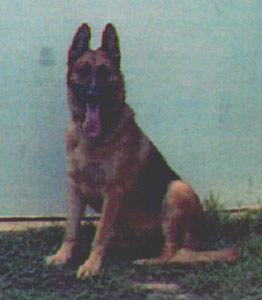 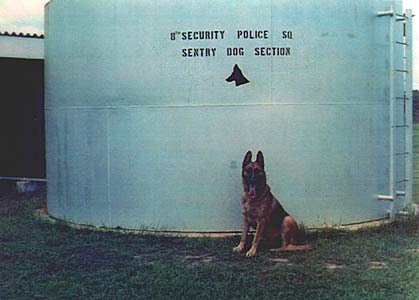
|
|